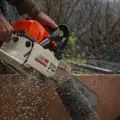A chainsaw is a portable, mechanical, and powerful tool that gives the user the ability to cut through tree trunks, branches, and other types of wood with its rotating sharp-edged metal teeth. They are typically used for projects such as limbing, pruning, harvesting firewood, bucking, and felling.
This powerful tool consists of two main parts, the saw blade, and the cylinder. The former is built into the chain and has a long metal guide bar wrapped around it. The latter is a small cylinder containing gasoline or petroleum, but sometimes it can be a battery pack or cord, depending on what type of chainsaw it is.
The key difference which separates a chainsaw from a hand saw is that a hand saw functions when it is being pulled back and forth manually to cut the wood, whereas a chainsaw is powered by a metal chain that keeps rotating to cut through the wood.
Since the first chainsaw was created during the 1920s, a lot has changed in its design and the various types available. Making sure you purchase the right kind of chainsaw can be a difficult task for people, especially those who lack sufficient chainsaw experience. This is why it is so important to be aware of the different types of chainsaws before going out and buying one.
This article will provide you will all the relevant information on the different types of chainsaws.
Table of Contents

Types of Chainsaws
Even though each type of chainsaw serves the same purpose, a lot of thinking is required into making the decision of choosing the right chainsaw. You will want to ask yourself what you intend to use the chainsaw for, how often will you use it, what’s your budget, and do you require a wireless or corded model?
Here are the different types of chainsaws available for you to pick from:
- Gas-powered
- Corded electric
- Battery-powered
- Pole saw
- Manual
- Mini chainsaw
- Hydraulic
- Pneumatic
Let’s take a look at each in more detail!
Gas Powered
Gas-powered chainsaws are certainly the most popular option amongst not only professional users but also DIY homeowners. As the name suggests, a gas-powered chainsaw is powered by gas. These types of chainsaws have a 2 cycle or a two-stroke engine that mixes oil and gas together to power the chainsaw.
The oil is used as lubrication for the internal part of the engine while preventing wear and tear, and the gas is used for combustion. You must ensure that you have a perfect ratio mixture of oil and gas otherwise you may experience problems. These chainsaws require regular maintenance so that they can work properly.
Gas-powered chainsaws are known for their power, portability, and loud noise. One of the main reasons people choose gas chainsaws is that their cutting performance and speed cannot be matched by electric or battery models. Here’s an example of a gas-powered chainsaw readily available on Amazon:
- With the OxyPower engine technology, you can get that extra power for virtually any task. This technology offers a more powerful engine, but also 70% less emissions and 20% lower fuel consumption
Prices pulled from the Amazon Product Advertising API on:
Product prices and availability are accurate as of the date/time indicated and are subject to change. Any price and availability information displayed on [relevant Amazon Site(s), as applicable] at the time of purchase will apply to the purchase of this product.
Corded Electric
Corded electric chainsaws, as you will have guessed, run on electricity and have a power cord that must be plugged into a wall socket. They do not have engines as they do not run on fuel. Corded electric chainsaws are considered to be immobile rather than portable because they need to be plugged in when they are being used.
However, with the help of a portable generator, you will be able to make the most of this chainsaw. You can also use a long extension cord to plug the chainsaw into and use it in various locations that plugging into a wall socket wouldn’t permit. Keep in mind, though, that a corded electric chainsaw cannot be used for certain tasks such as felling in tree woods. They are more suitable for DIYers who focus on smaller tasks at home.
In comparison to gas-powered chainsaws, the corded electric chainsaw has less power and can be limited tasks (the ones that do not require much more). However, they are more powerful compared to battery-powered chainsaws, and they can do numerous tasks like cutting and sawing small trees, limbs, and thick branches which a battery-powered chainsaw would struggle with.
Corded electric chainsaws do not produce the fumes or noise that a gas-powered chainsaw does. Additionally, as they are more lightweight, they can be easily used by inexperienced users to perform basic tasks around the house. Corded electric chainsaws are fairly cheaper than gasoline-powered chainsaws but more expensive than pole saws or manual chainsaws.
Note: In many cases, they require special extension cords so that they can perform to their full potential.
The disadvantage of a corded chainsaw is that it cannot be used when they are not plugged in. Even if you use a portable generator as your power source, you will need to be very careful with the cord to ensure it doesn’t get tangled in the woods. This is why a corded electric chainsaw is generally recommended against for any use in the woods.
Here’s an example of a corded electric chainsaw readily available on Amazon:
- 10.5 amp electric motor starts within seconds for ease of use and Reliable power
Prices pulled from the Amazon Product Advertising API on:
Product prices and availability are accurate as of the date/time indicated and are subject to change. Any price and availability information displayed on [relevant Amazon Site(s), as applicable] at the time of purchase will apply to the purchase of this product.
Battery Powered
Battery-powered chainsaws, otherwise known as cordless chainsaws, are designed to work on batteries instead of fuel or need a constant electricity source. The batteries generally need to be charged in advance which can halt operation.
Sure, they offer the benefit of not having to get regular fueling or servicing completed like you would with a gas-powered chainsaw or the limitations of needing an electrical power output like the corded electric chainsaw, but you need to charge the batteries to keep the chainsaw working.
When you run out of battery charge, you will be limited in the amount of work that you can complete in one session. The trick here is to have multiple batteries available so that as one dies you can replace it and place the other one on charge.
Battery-powered chainsaws are designed for light tasks such as limbing, trimming, pruning, and cutting small trees. They understandably do not have the same amount of power as corded electric chainsaws. They typically are best suited for easy tasks that do not take much time.
Even though they are not capable of providing the same amount of power as corded electric and gas-powered chainsaws, battery-powered chainsaws are the most expensive type of chainsaw due to the costs of the battery technology.
- Speed: 6800 RPM
Prices pulled from the Amazon Product Advertising API on:
Product prices and availability are accurate as of the date/time indicated and are subject to change. Any price and availability information displayed on [relevant Amazon Site(s), as applicable] at the time of purchase will apply to the purchase of this product.
Pole Saw
A pole saw is a saw that is attached to an extension pole to help you easily reach and cut, eliminate, or trim tree limbs. Pole saws are designed to trim trees in harder-to-reach areas, like overhead tree branches that would be difficult to cut otherwise. Pole saws cannot be considered chainsaws, but they are similar in some aspects.
These pole saws can be either gas-powered, battery-powered, or corded. The gas-powered pole saws are more powerful compared to electric ones. They will also make a lot more noise and vibration due to the engine components.
The electric ones have less power and are more suited to be used for lighter tasks. Battery-powered pole saws are, of course, the most expensive, and then gas-powered ones, and finally, corded pole saws just as chainsaws are in general.
Here’s an example of a pole saw readily available on Amazon:
Manual
Manual chainsaws do not require gas, electricity, or batteries, and as you may have guessed, they require manual operation. Though, they’re labeled as “chainsaws”, they’re more of a hand saw and are not sold by chainsaw suppliers. They are often designed by using a saw chain and other materials for hand grips.
This means that you need to take the saw chain and manually use it to cut wood. Instead of it being powered, you will need to exert your own power on the chain to cut the wood. They’re best suited as more of a “survival saw” as they pack up very small and can be taken on any sort of camping exploration.
This chainsaw will often be used for light camping/survival tasks such as trimming wood or firewood, but they’re not that popular. Sure, they do not produce any noise, but they do consume a lot of your energy as their hard work.
Manual chainsaws may not exert as much power as other chainsaws, but they are extremely portable and faster than other handheld chainsaws. Compared to the other chainsaws, this option is very cheap if it matches your requirements.
Here’s an example of a manual saw readily available on Amazon:
Prices pulled from the Amazon Product Advertising API on:
Product prices and availability are accurate as of the date/time indicated and are subject to change. Any price and availability information displayed on [relevant Amazon Site(s), as applicable] at the time of purchase will apply to the purchase of this product.
Mini Chainsaw
The latest type of chainsaw to hit the market is the mini chainsaw. And it’s exactly what you think it is, it’s a mini-chainsaw design that you can hold in one hand. They are designed similar to a power tool like a battery-powered drill. These mini-chainsaws are used primarily for pruning large branches as they can rip through sizeable branches very quickly. They can also cut down smaller trees with ease.
They typically don’t cost too much. So, whether you cut down trees/branches regularly or are a homeowner with some unruly branches, this type of chainsaw could be a great tool to have in your shed or garage.
Here’s an example of a mini-chainsaw readily available on Amazon:
- 🍀A Gift for Welcoming Spring! Take it for Camping, for Pruning Your Yard!
Prices pulled from the Amazon Product Advertising API on:
Product prices and availability are accurate as of the date/time indicated and are subject to change. Any price and availability information displayed on [relevant Amazon Site(s), as applicable] at the time of purchase will apply to the purchase of this product.
Hydraulic Chainsaws
As the name suggests, hydraulic chainsaws work using high-pressure liquid as their power source. Therefore, it has no motor or engine. This allows for the hydraulic chainsaw to be waterproof. The hydraulic chainsaw actually has very few moving parts in a hydraulic chainsaw, almost just the chain and gear that rotates the chain around the bar of the hydraulic chainsaw.
This more industrial type of chainsaw is only used by professionals for specific underwater projects. The main reason a hydraulic chainsaw can be submerged underwater is that the hydraulic fluid is being circulated through the chainsaw using a pump above the surface of the water to power it.
The pump can be stored on a boat and can be used to run the hydraulic chainsaw to cut fallen trees, logs, or vegetation underwater. The lack of an engine and motor, amongst other parts, makes them very light and easy to use it underwater. Of course, these types of chainsaws are not cheap.
More about parts of a chainsaw on the blog.
Pneumatic Chainsaws
A pneumatic chainsaw is another type of industrial chainsaw that is designed to work underwater and doesn’t have a motor or engine. Though they’re quite similar, the main difference between the two lies in the power source.
A pneumatic chainsaw requires compressed air or gas to circulate through in order to force the chain to rotate. The air or gas is pumped into the pneumatic chainsaw through a pump connected to the chainsaw from an air compressor, using hoses similar to hydraulic chainsaws.
However, apart from being capable of being used underwater, pneumatic chainsaws can be used in tunnels where you can’t use a regular gasoline chainsaw due to the presence of methane or other explosive gases that can cause an explosion.
Therefore, pneumatic chainsaws are used in industrial applications to cut steel, wood, and even concrete, making them the most powerful of all the chainsaws. Again, just like hydraulic chainsaws, these types are quite expensive and are only necessary for the applications mentioned.
Type of Chainsaw Buying Considerations
When you’re trying to make a decision on the type of chainsaw you wish to buy, other than the evident various types available, there are a number of other considerations you should have in mind. These include:
- Intended use
- Handle design
- Chain size
- Experience
- Budget
- Safety features
Intended Use
Your first consideration should be what do you intend to use the chainsaw for? Chainsaw manufacturers design chainsaws so they can be used by different people for many different uses. There are chainsaw options suitable for, industrial processes, professional loggers, and occasional home users.
If you need a chainsaw to occasionally trim trees and limbs or to cut firewood, there is certainly no need to invest in a heavy-duty gas-powered chainsaw that is used by professionals for logging.
Handle Design
When it comes to the design of the chainsaw, other than the different types of chainsaws already presented, we also have the handle design to consider. This excludes pole saws and manual chains. There are typically two handle designs to choose from:
- Top handle
- Rear handle
Top Handle
In short, top handle chainsaws are for tree surgeons and other professional tree cutters. The top handle design is made for cutting trees at very tall heights. Professionals who use top handle chainsaws will often climb trees and are supported by a harness. The top handle allows the user to better maneuver the tool while at these tall heights.
However, some professionals may also use these smaller chainsaws to cut wood from ground level. Top handle chainsaws are generally found in 12-inch or smaller bars and chains.
Rear Handle
Rear handle chainsaws, on the other hand, are for both professional and non-professional use. The position of the rear handle gives the operator more control over the chainsaw and is the most common handle design.
Rear handle chainsaws are used for all types of projects such as felling trees, cutting up logs, slicing firewood, trimming branches, and more tasks that are performed while standing on the ground.
Chainsaw Chain Size
Typically decided along with your intended use and the handle design. But, after determining what type of chainsaw you require, you will need to decide what size chainsaw chain you need to get. A good rule of thumb is that the bar length, which is the length of the blade while the chain is rotating around, should be a minimum of 2 inches longer than the wood you intend on cutting.
It’s necessary to have a longer bar length so that you are able to cut safely. Sure, it is possible to cut bigger pieces of wood with a smaller bar length, but it will require extra safety measures.
It’s generally recommended to get a chainsaw chain between 12 and 14 inches if you are cutting trees with soft foliage, small branches, or are younger. Therefore, an electric chainsaw will probably suffice.
If you are planning on cutting down larger branches or tree trunks, then it is advised to opt for a chainsaw that has a chainsaw bar length of between 16 and 20 inches. This will require you to invest in a high-tier cordless chainsaw or a gas-powered one because portability will be key.
If you are cutting large trees on a daily basis, then you will need to consider getting a chainsaw that is larger than 20 inches. This will come at an additional cost, but it will make your job a lot easier. For information on how to measure chainsaw bar, visit our guide!
Experience
When it comes to experience, if you have never used a chainsaw before, the smart choice is to opt for a chainsaw that is smaller in size because they are safer and easier to use. Therefore, the ideal choice would be a corded electric chainsaw or a battery-powered chainsaw.
If you have a great experience, then I’m sure you won’t need advice, but purchase whatever chainsaw is suitable for your applications.
Budget
Budget is always an important consideration. If you have a low budget, you will need to consider purchasing a corded electric chainsaw because they are a cheaper option compared to all the others. But, the budget can be tricky because it’s more important to purchase a chainsaw that suits your job requirements.
Safety Features
When you are purchasing a chainsaw, you should always consider the safety features. Some to look out for are:
1. Chain brake
The greatest hazard when working with a chainsaw is if the saw kicks back. Kickback can happen when something contacts the upper quadrant of the tip of the bar, or if you try to cut with that same quadrant.
The bar tip will then try to climb upwards, and the saw will be thrown backward by the force of the rotating chain. This is why the chain brake is a very important safety feature of the chainsaw. When activated, it can stop the chain in a fraction of a second in the case of a kickback.
2. Chain catcher
If the saw chain is not maintained properly it may jump off or break. The chain catcher is designed to protect the operator by stopping the chain from flying backward in any case.
3. Right-hand guard
The right-hand guard is designed to protect your fingers if the chain ever decides to jump off or break.
4. Throttle lock
Throttle locks prevent accidental throttle operation. As an additional safety feature, you must activate the throttle lock to be able to operate the throttle.
5. Stop button
Conveniently positioned so you can stop the engine quickly.
FAQs (Frequently Asked Questions)
What type of chainsaws are best?
The best type of chainsaw will typically depend on your application. Battery-powered chainsaws are designed for light tasks such as limbing, trimming, pruning, and cutting small trees. While gas-powered chainsaws are designed for more heavy-duty tasks like cutting larger trees.
How do I choose a chain saw?
The first consideration should be based on what applications you intend to use the chainsaw for. Each type of chainsaw is designed with specific applications in mind. After that, you should consider your budget, skill level, and safety features.
What is a good chainsaw for cutting trees?
Gas-powered chainsaws are best for cutting trees as they have more power, can drive long 20-inch bars, operate at greater speeds, and have longer run times than electric chainsaws, making them ideal for cutting larger trees and branches or bigger jobs involving multiple trees.











